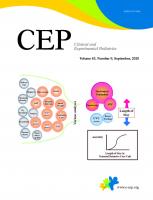Inflammatory bowel diseases (IBDs) are immune-related chronic intestinal inflammatory conditions including the two prototypes of Crohn disease (CD) and ulcerative colitis (UC). IBD except for the early-onset phenotype is a multifactorial disease with an unclear pathogenesis. Complex interactions between susceptible genes and one or more environmental factors are possible drivers in IBD development [1]. Genome-wide association studies and next-generation sequencing studies have identified over 200 genetic loci associated with IBD [2,3] that comprise 19% and 26% of the heritability for UC and CD, respectively [3]. Therefore, susceptibility genes cannot explain the worldwide increasing rate of IBD over time, especially in Western countries, East Asia, and many newly industrialized countries [1]. The human genetic constituents have barely changed during its long evolutional history. Thus, the increasing incidence of IBD seems to be more likely related with exposure to various environmental factors rather than genetic factors [1]. This is supported by epidemiologic observation data on immigrants from low incidence regions to high IBD incidence countries that the second generation of immigrants show a similar risk of IBD development as does the indigenous population [4].
Among the environmental factors, diet appears to play a plausible role in building the physiologic gut microenvironment and contributing to the development of IBD. In a review article, Park at al. described the dietary role as an environmental factor in developing inflammatory bowel disease [5]. Complex carbohydrates, fiber-rich vegetables, and fruits have beneficial implications in gut homeostasis [1,6]. Short-chain fatty acids (SCFAs), mainly butyrate, which is produced from the bacterial fermentation of nondigestible carbohydrates or amino acid degradation, demonstrate an anti-inflammatory property through immunomodulation in both innate and adaptive immunity [6,7]. Butyrate also induces mucus production by stimulating the epithelial cells and rearrange tight junctions [7]. A systemic review showed that fiber- and fruit-rich diets were associated with a low risk of CD, while a vegetable-rich diet was associated with a low risk of UC [8]. On the contrary, Westernized nutritional habits, including the consumption of high amounts of animal fat and refined sugar, low amounts of fiber, and the food additive carrageenan, have been suggested as possible triggers in IBD development [6]. The Western diet (WD) may alter the composition and function of the gut microbiota (dysbiosis), which is associated with poor production of beneficial microbial metabolites such as SCFAs and destruction of the mucosal barrier due to expansion of colonic mucus-degrading bacteria [6,8]. The WD is also associated with facilitating production of pro-inflammatory cytokines and modulating intestinal permeability [6]. Several epidemiologic studies have shown that a diet with high amounts of saturated fatty acids and animal proteins is linked to an increased risk of IBD [8]. Emulsifiers and artificial sweeteners induce chronic gut inflammation and weaken the gut barrier function [6]. Although the role of diet in development and progression of IBD is not fully understood, it is obvious that chronic WD exposure can induce dysbiosis and low-grade gut inflammation. Dysbiosis has been documented in many IBD patients and is accepted as playing a key role in gut inflammation [6,8]. However, it remains unclear whether dysbiosis is a cause or a change as a consequence of IBD.
According to the evolving landscape of diet role for gut homeostasis, dietary therapies have been applied primarily in CD. Dietary interventions have some advantages including its physiologic property in remission induction through restoration of gut microbiota balance. With the introduction of biologics, the target of treatment has shifted from relieving symptoms to achieving mucosal healing using a target to target strategy. Park at al. showed recent data on the efficacy of dietary modification and modulation of intestinal microbiota in the biologic era [5]. Exclusive enteral nutrition (EEN), the first introduced dietary intervention, achieves mucosal healing and has similar remission rates to those of corticosteroid in cases of newly diagnosed as well as relapsed pediatric active luminal CD [6,9]. EEN improves endoscopic severity and histology, supports continuous growth, and minimizes side effects [6]. EEN possibly influences the gut bacterial milieu, which results in downregulating immune activation by decreasing proinflammatory cytokines and restoring barrier integrity [9]. EEN has unsolved problems with low compliance due to its tasteless palatability and sparse long-term outcomes. To improve these problems, other various dietary interventions have been implicated [9-11]. A recent study showed that the CD exclusion diet plus partial enteral nutrition was effective for maintaining sustained remission in mild to moderate pediatric CD [10]. Other various dietary interventions including the specific carbohydrate diet, CD exclusion diet, CD-TREAT diet (solid food mimicking the composition and effects of enteral nutrition), and anti-inflammatory diet have been implemented to help IBD treatment with varying degrees of data quality in children [9,11]. The effects of these formulations are still being evaluated (Table 1). Such works may not only lead to dietary changes preventing IBD but also achieve long-term disease control with good clinical outcomes and quality of life. Furthermore, it can be expected to inform microbiota modulating therapeutic approaches through further dietary-related studies on IBD and a better understanding of the human gut ecosystem.





 PDF Links
PDF Links PubReader
PubReader ePub Link
ePub Link PubMed
PubMed Download Citation
Download Citation


